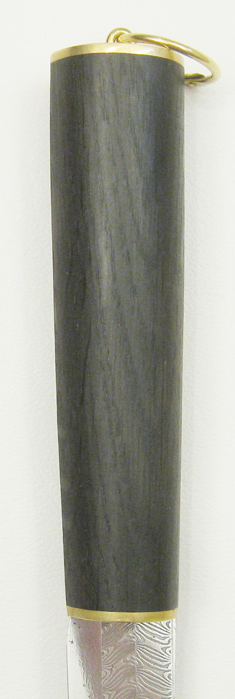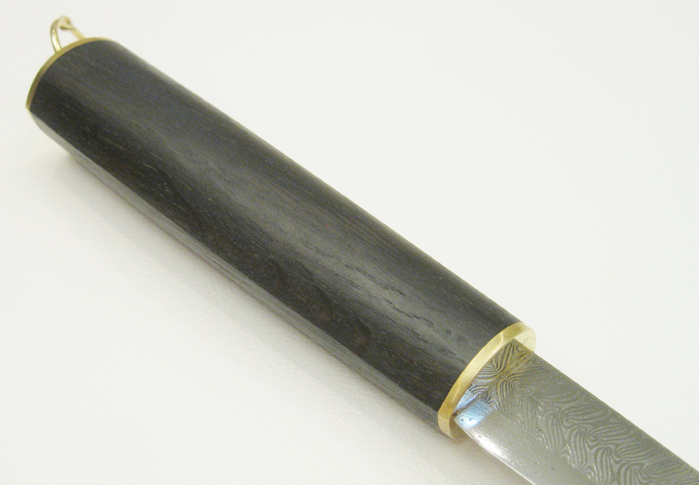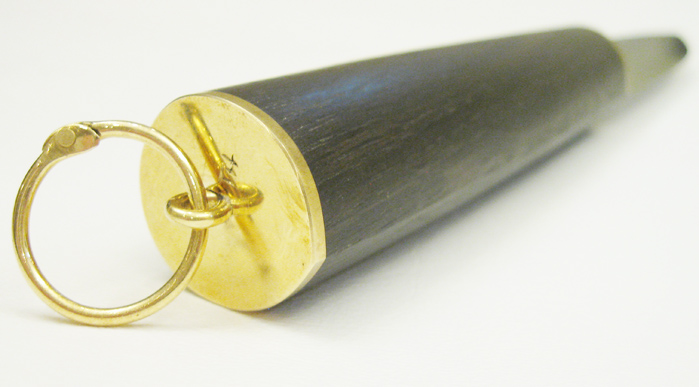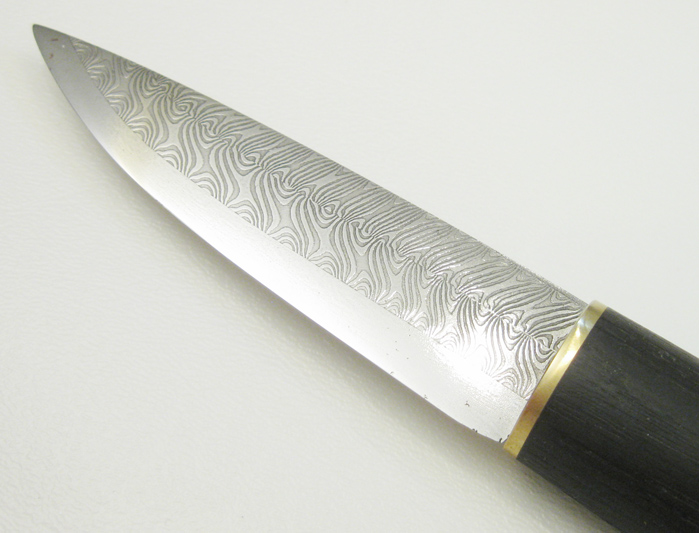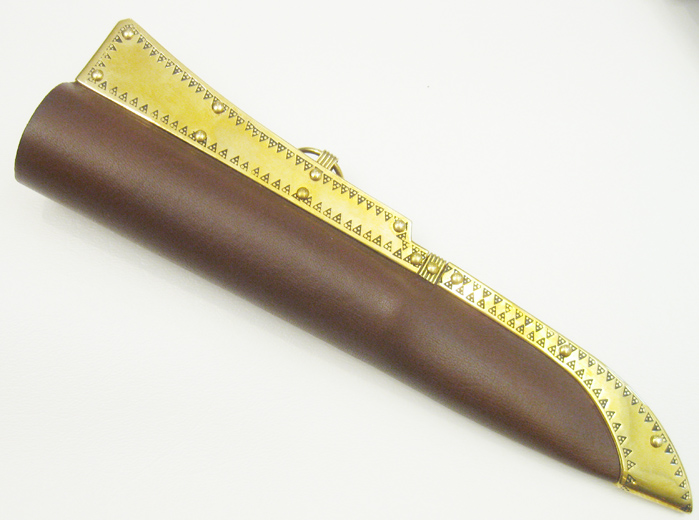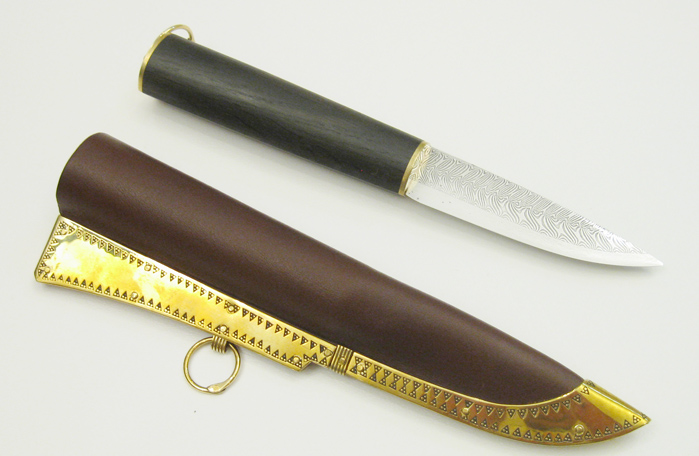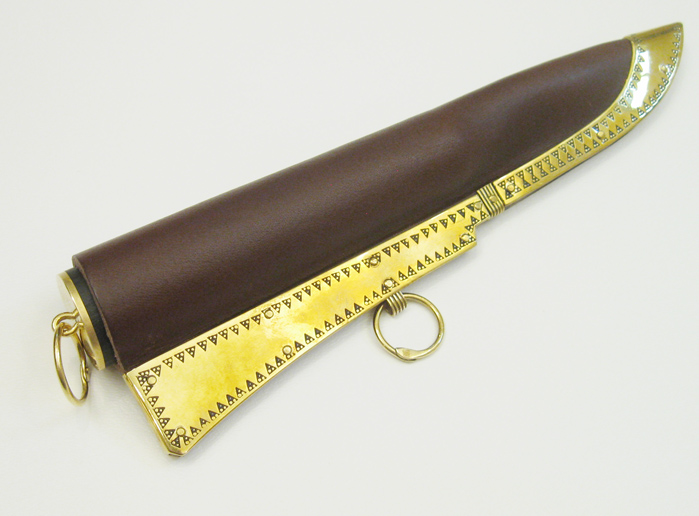Ranging in size from small utility knives to sword-length weapons, the sax (or seax) saw use for centuries. Though the form is most commonly associated with Viking cultures, it was in use by the 5th or 6th century and continued into the 11th century and perhaps beyond. A defining characteristic is a single-edged blade, though that took many shapes throughout the saxís long history. While many are familiar with the broken-back sax, simpler blade profiles with straight or slightly down-curving spines were also popular at different times and locales. Grips were typically of wood or other organic material and could be decorated with metal plates at either end, wire-wrapped sections, or many other materials and techniques.
Many blades were constructed via pattern-welding. In an era where quality steel may have been less plentiful, a bladesmith could save the best material for the edge. The bladeís spine did not need to be as hard as the edge and a forge-welded mix of metals that could include softer steels and iron would not be detrimental. The back and edge would then be forge-welded together to complete the blade. The layers and seams produced by this process created patterns in the steel itself. Sometimes called Damascus steel in modern knife-making, this construction and its myriad of visual patterns remains popular today.
Overview
Iíve owned a number of saxes through the years, but have always wanted one with a pattern-welded blade. When searching through Etsy.com, a website where craftspeople and sellers list millions of handcrafted and vintage items for sale, I encountered a beautiful sax by Grzegorz Kulig, known as Thorkil. Though I knew him better as an armourer who makes detailed and accurate pieces from many eras, his Etsy site listed this sax as well as many beautiful and well-crafted examples of Viking-age jewelry. The sax was purchased through Etsy (with payment via PayPal) and arrived from Poland to my home quickly via FedEx. Thorkil has since shuttered their Etsy presence, but can still be found at http://www.thorkil.pl/main.htm
Measurements and specifications:
Weight: 2.625 ounces
Overall length: 8 1/4 inches
Blade length: 3 5/8 inches
Blade width: 7/8 inches at base, tapering to 5/8 inches
Grip length: 4 3/8 inches
Guard width: 7/8 inches
Replica created by Thorkil of Krosno, Poland.
Handling Characteristics
With its light weight, this sax is easy to wield; it is obviously not meant to be a battlefield weapon. The grip is a good size for my hand and allows easy control and movement. Somewhat curiously, the belly of the grip features a noticeable ridge that gives the grip a cross-section like a very fat teardrop. This feature usually sits in the creases of your fingers and also helps align and lock the sax in the sheath. The saxís blade is quite sharp.
Fit and Finish
While some saxes (originals and replicas) are ornate weapons, this knife is somewhat austere in appearance. The bolster and buttcap are brass and are well-fitted to the black oak grip. The buttcap features a riveted brass ring and Thorkilís ďTHĒ mark. The entire hilt is well-shaped and evenly finished.
The blade really stands out; the pattern is beautifully executed. The pattern welded section is made of mild and spring steel; the edge is spring steel. Both sections are well-polished and shaped without wobbles.
Ironically enough, the scabbard is what ultimately made me decide to buy this piece. The core of the scabbard is thick, molded leather dyed brown; the sax fits tightly and almost completely inside. The brass work is extremely well-done throughout. Two sheets of brass wrap the seam of the scabbard; each section is riveted through the leather to itself. They are decorated with stamped triangles with three raised dots in each. Two ridged brass loops complete the metalwork: one sits between the sections of brass sheeting and one is used to anchor a riveted brass ring.
Conclusion
Overall, Iím very happy with this purchase. The sax is beautiful and appears to be very historically accurate. The pattern on the blade is interesting but is more subtle than some that Iíve seen. The craftsmanship on the scabbard is top-notch. All in all, it is a nice piece for a reasonable price.

